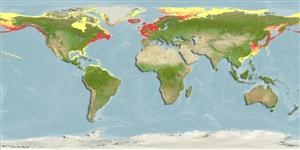Bivalvia |
Mytilida |
Mytilidae
Environment: milieu / climate zone / depth range / distribution range
Ecology
Benthic; depth range 5 - 280 m (Ref. 95810). Boreal; 85°N - 15°N, 115°E - 61°E
Arctic, northern Atlantic and Pacific. Boreal to polar.
Length at first maturity / Size / Weight / Age
Maturity: Lm ? range ? - ? cm Max length : 18.0 cm TL male/unsexed; (Ref. 95344)
Suspension feeder (Refs. 3477, 118257). Also found on fine and medium grain sized sand mixed with gravel and shell debris (Ref. 118257). Aggregates into mussel "mats" by binding gravel and rocks (Ref. 95344).
Life cycle and mating behavior
Maturity | Reproduction | Spawning | Eggs | Fecundity | Larvae
Members of the class Bivalvia are mostly gonochoric, some are protandric hermaphrodites. Life cycle: Embryos develop into free-swimming trocophore larvae, succeeded by the bivalve veliger, resembling a miniature clam.
Harvey-Clark, C. 1997 Eastern tidepool and reef: north-central Atlantic marinelife guide. Hancock House Publishers, 64pp. (Ref. 7726)
IUCN Red List Status
(Ref. 130435: Version 2025-1)
CITES status (Ref. 108899)
Not Evaluated
Not Evaluated
Threat to humans
Human uses
| FishSource |
Tools
More information
Trophic EcologyFood items (preys)Diet compositionFood consumptionPredators Life cycleReproductionMaturityFecunditySpawningEggsEgg developmentLarvae PhysiologyOxygen consumption
Human RelatedStamps, coins, misc.
Internet sources
Estimates based on models
Preferred temperature
(Ref.
115969): 0.9 - 11.9, mean 7.3 (based on 1243 cells).
Resilience
Low, minimum population doubling time 4.5 - 14 years (K=0.08).
Fishing Vulnerability
Moderate vulnerability (44 of 100).
